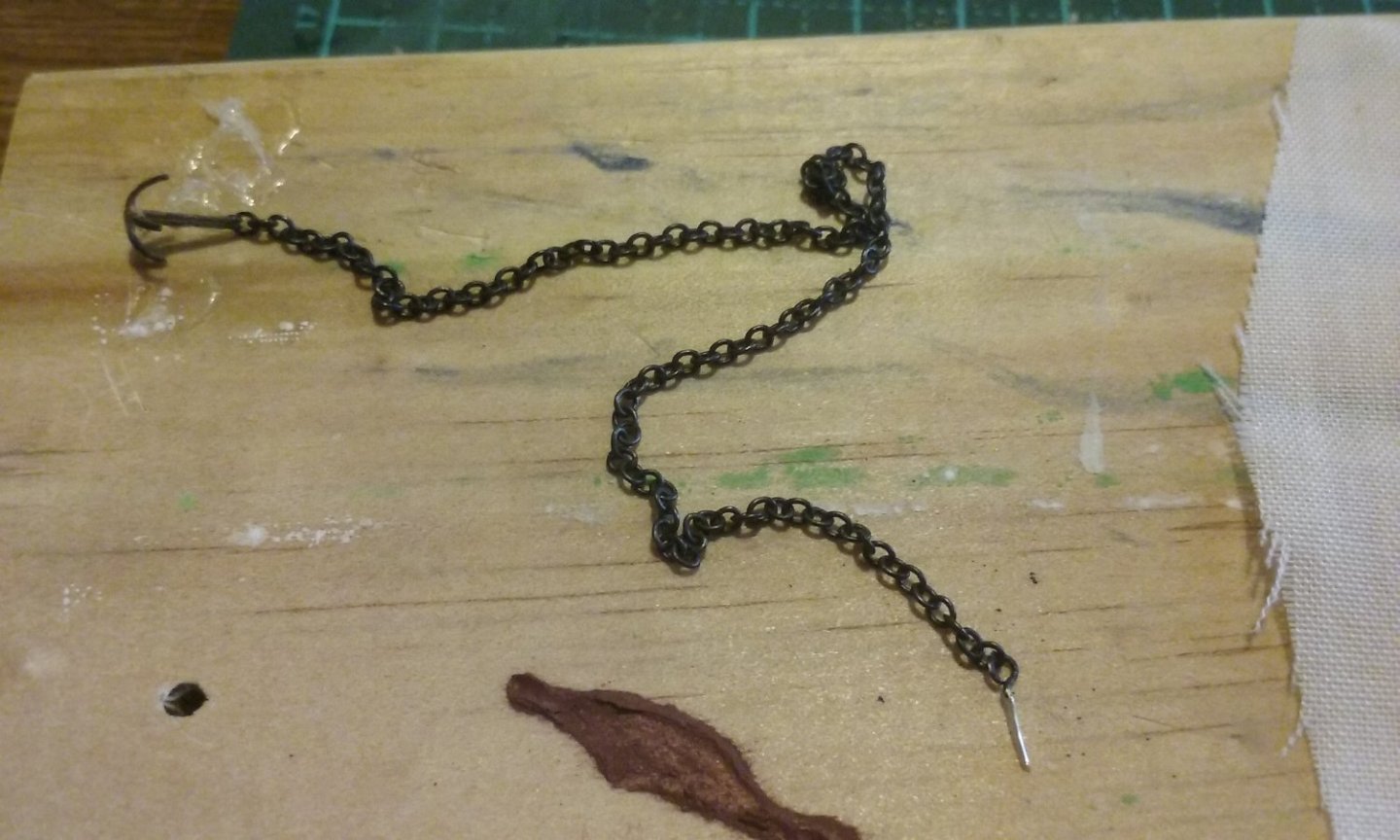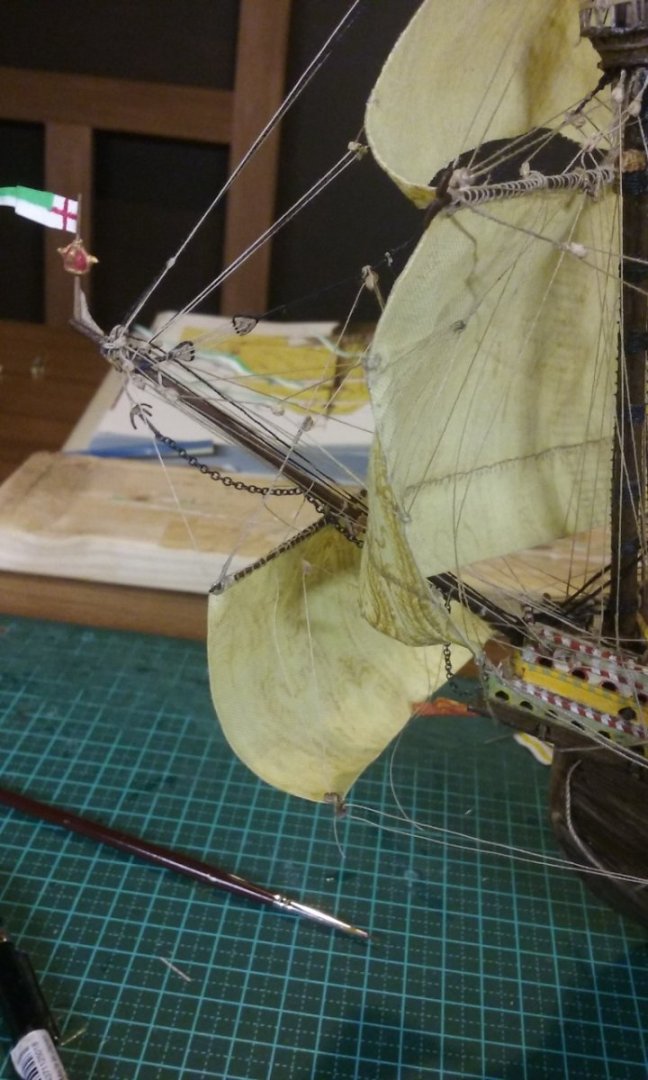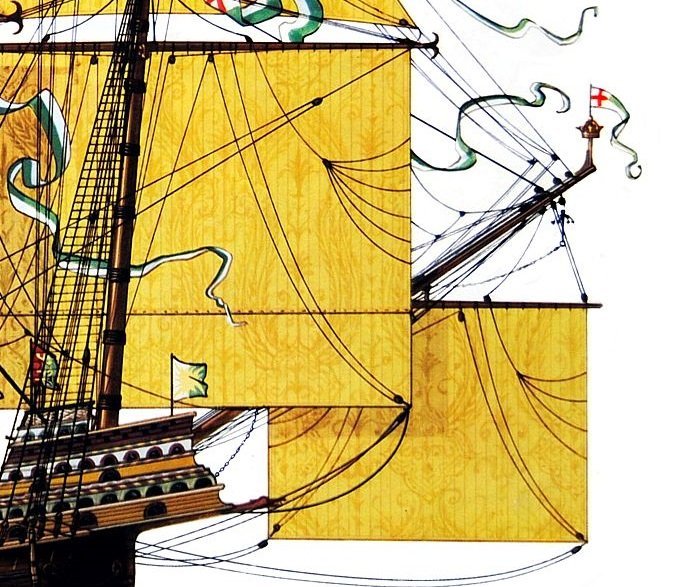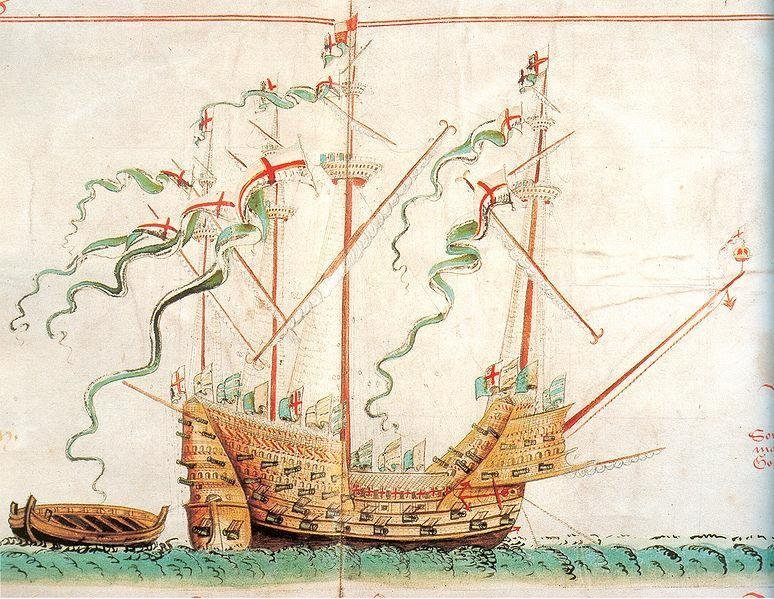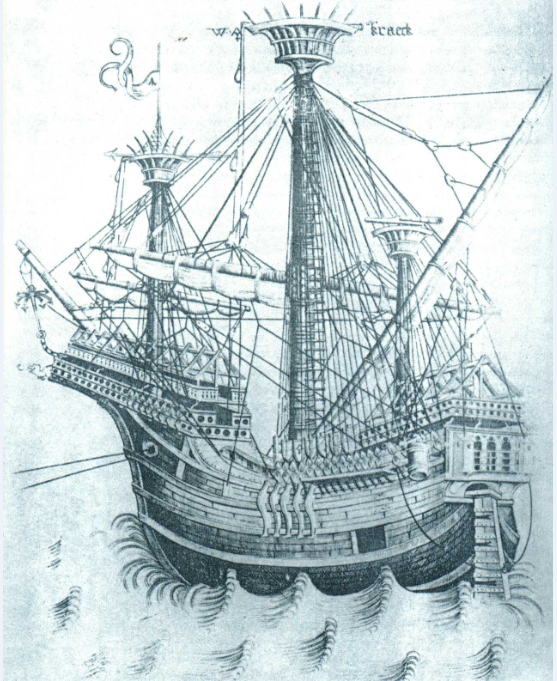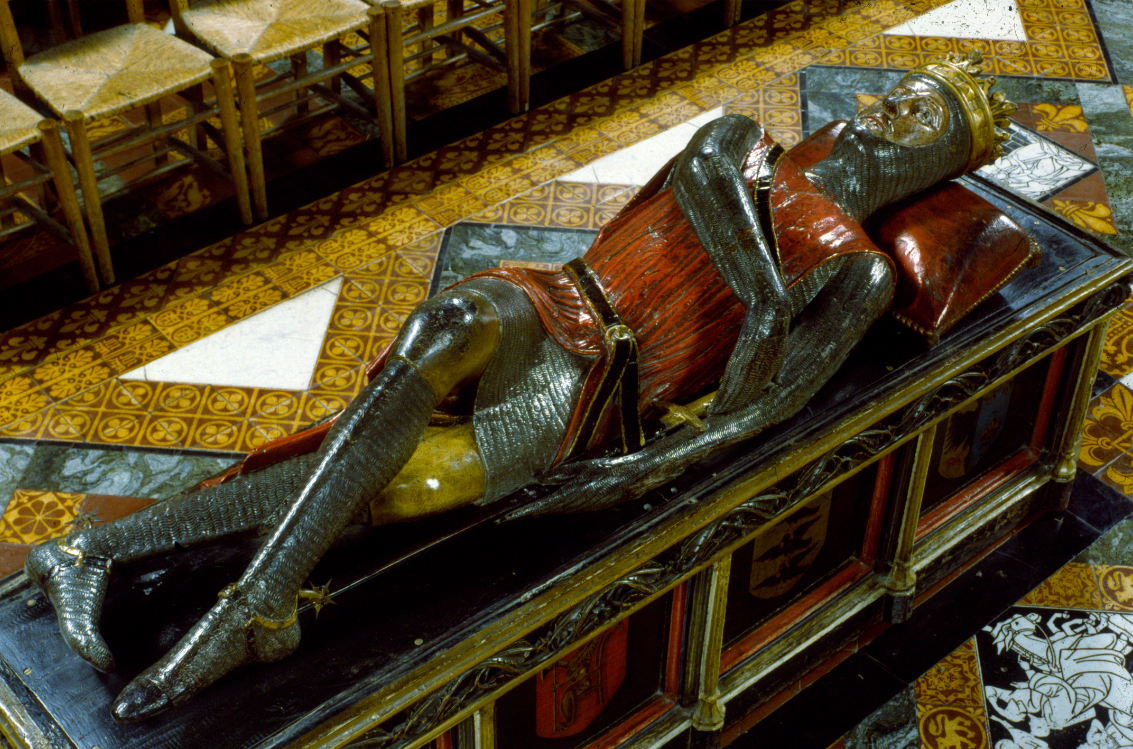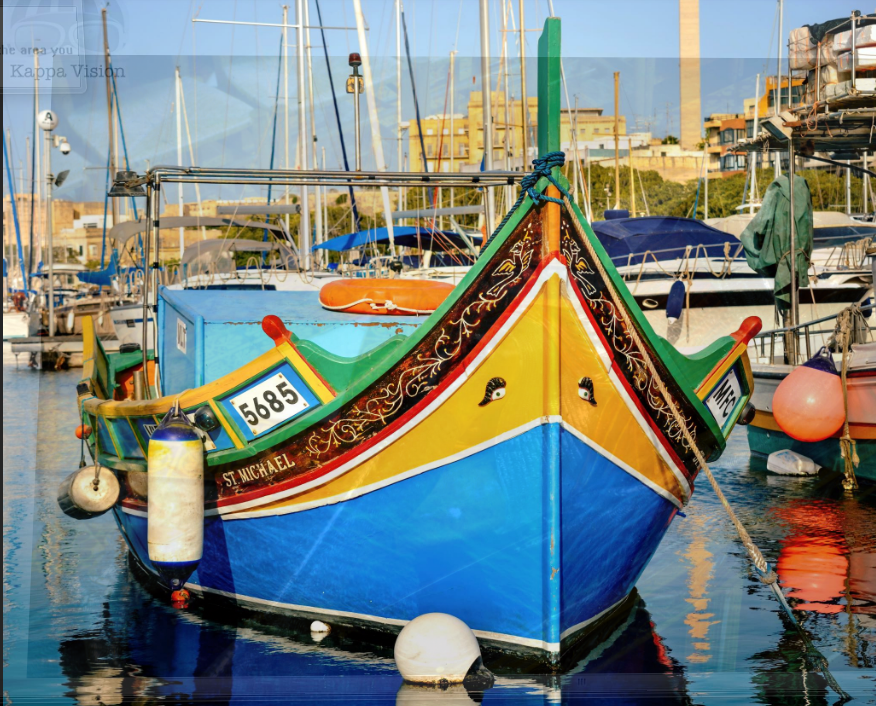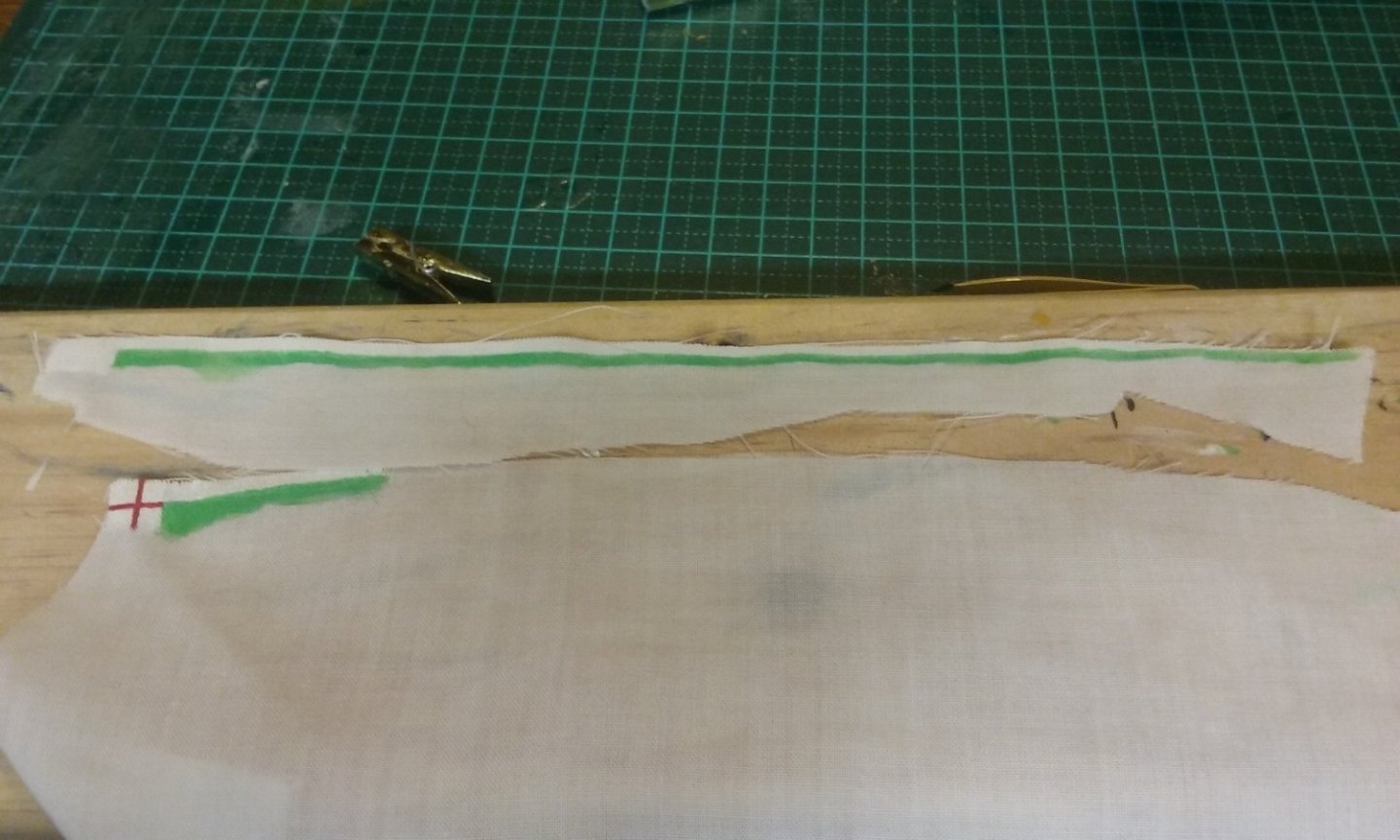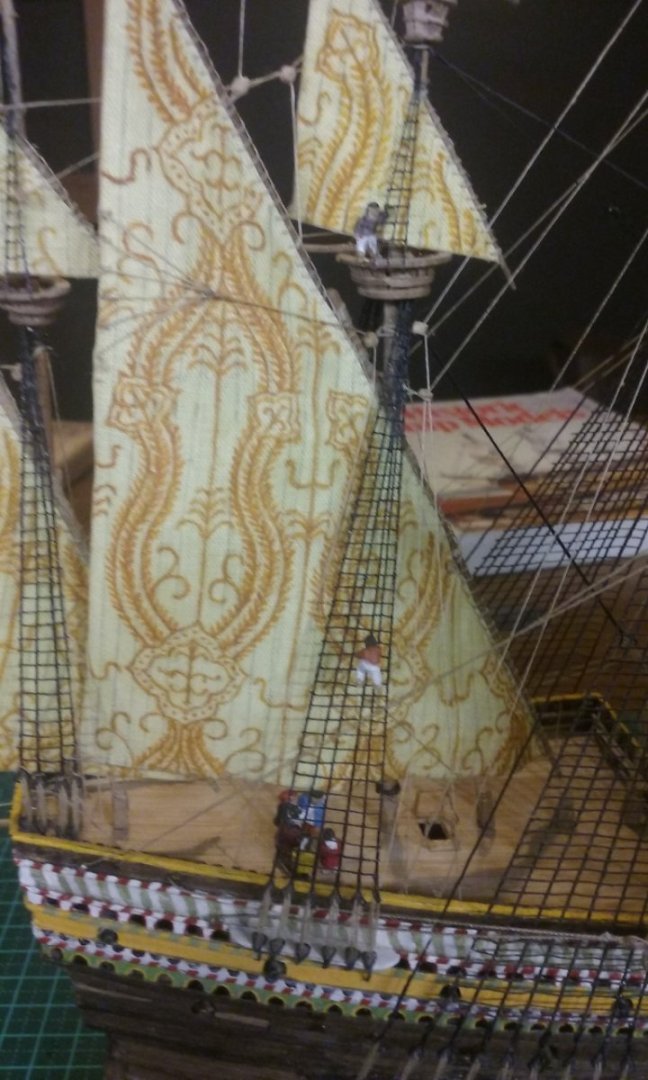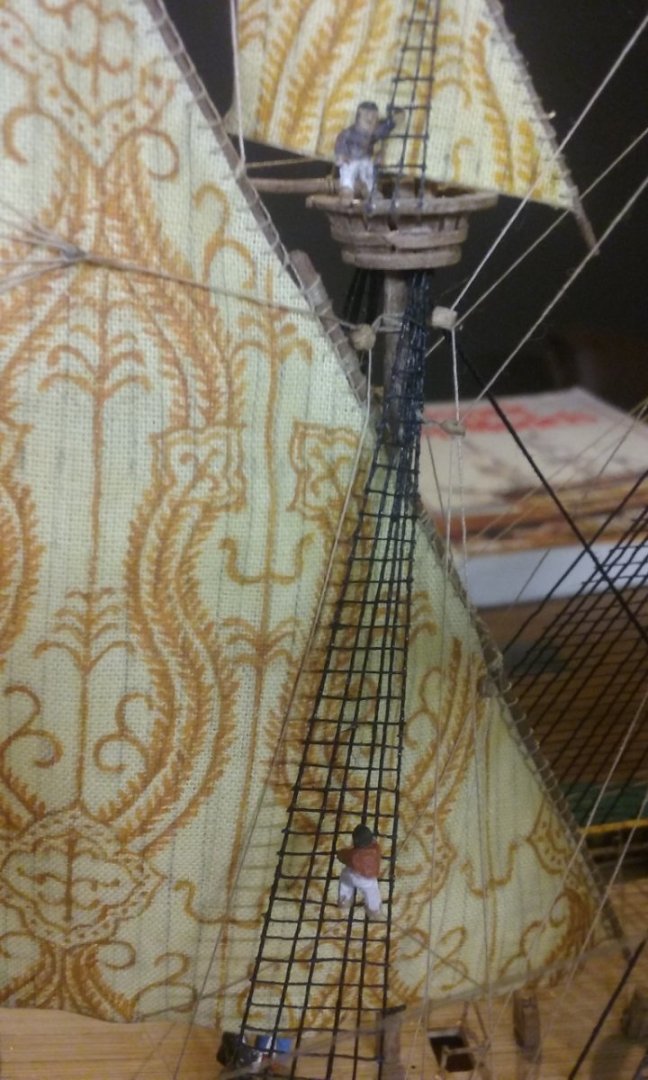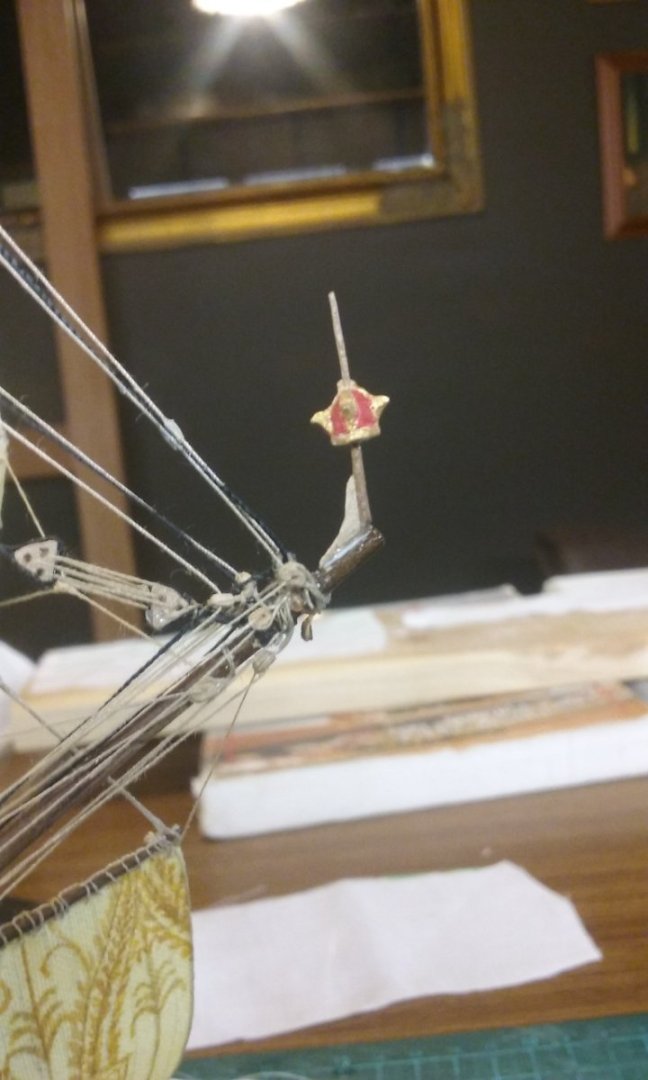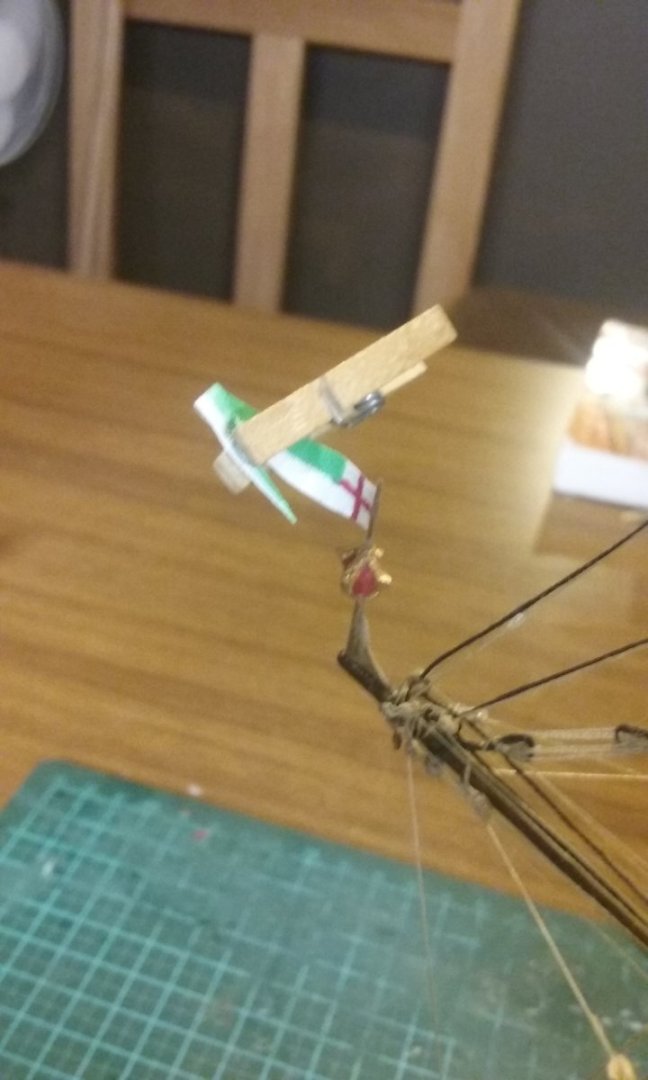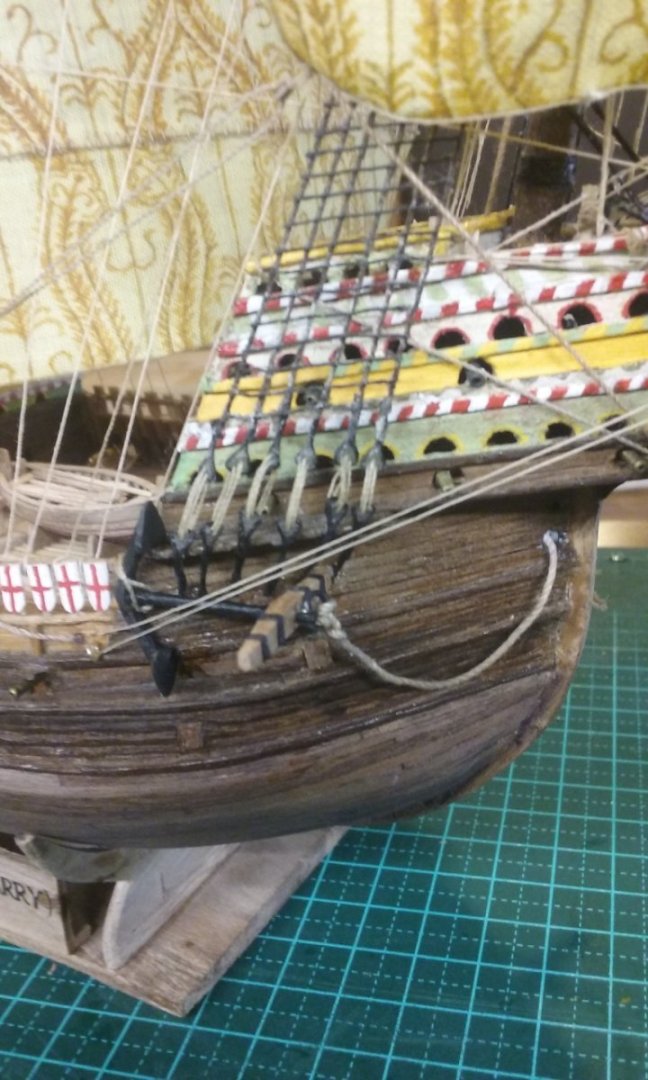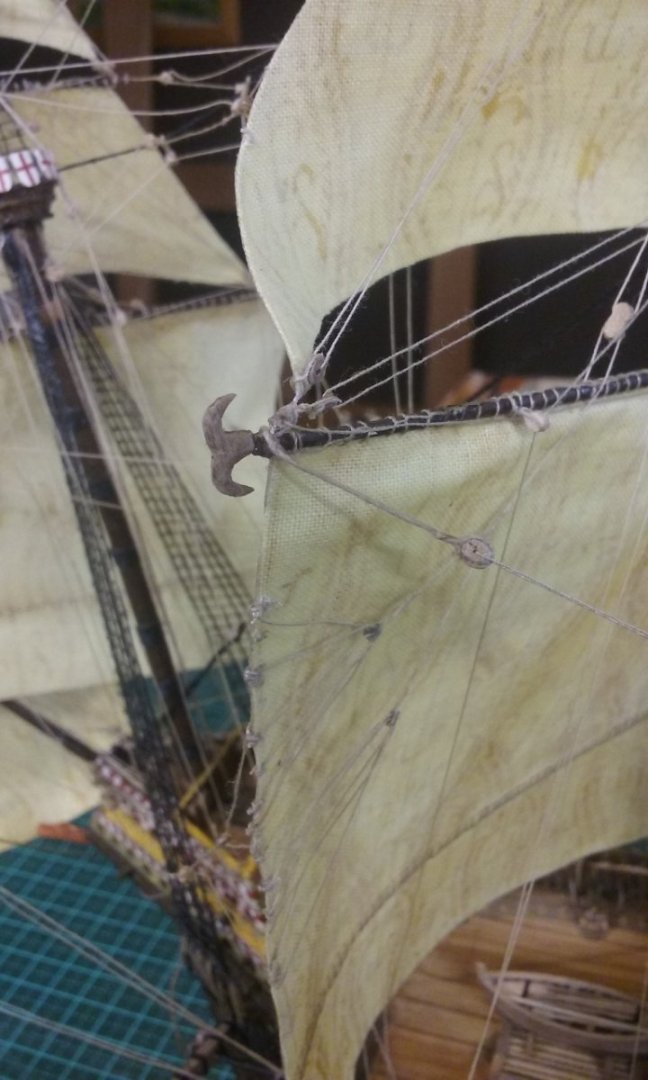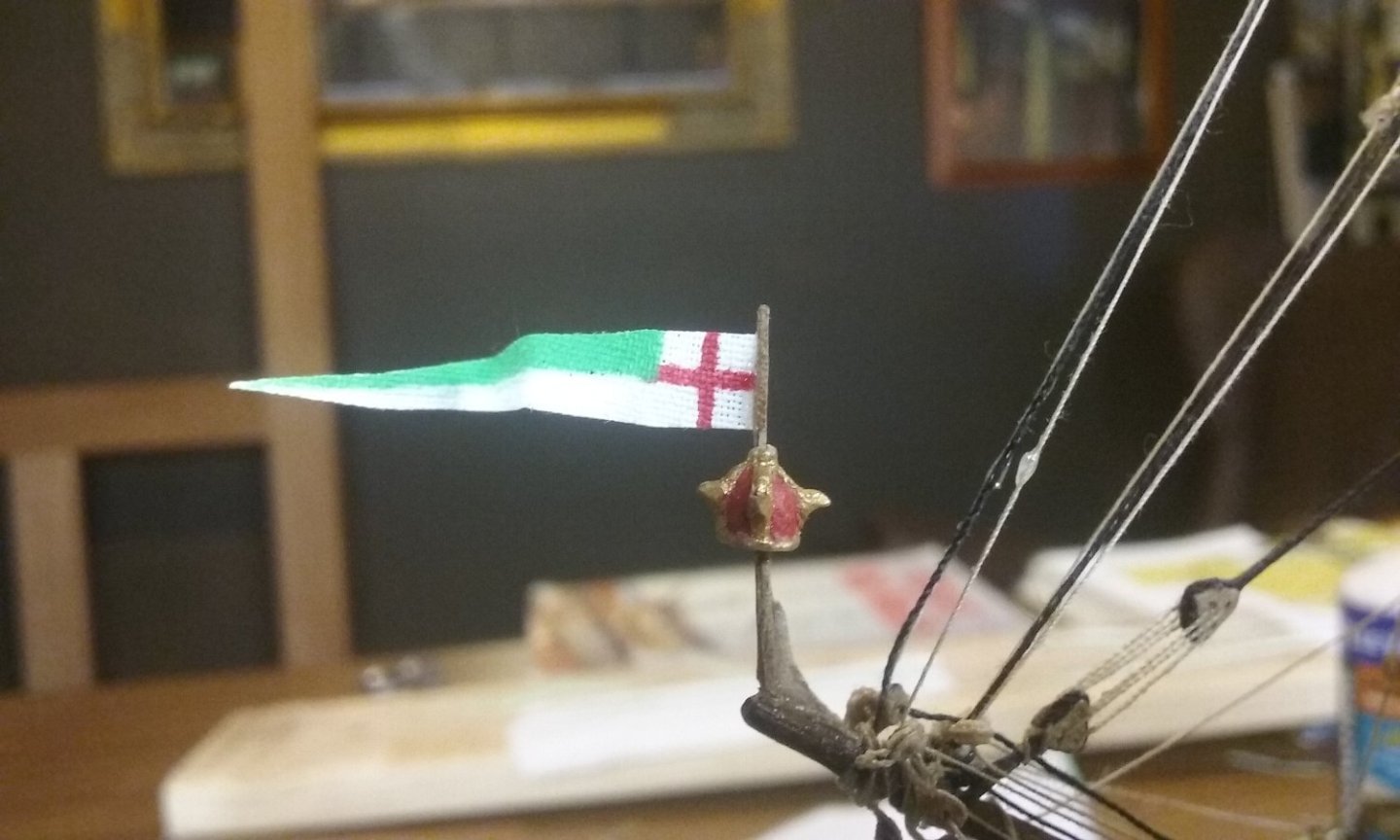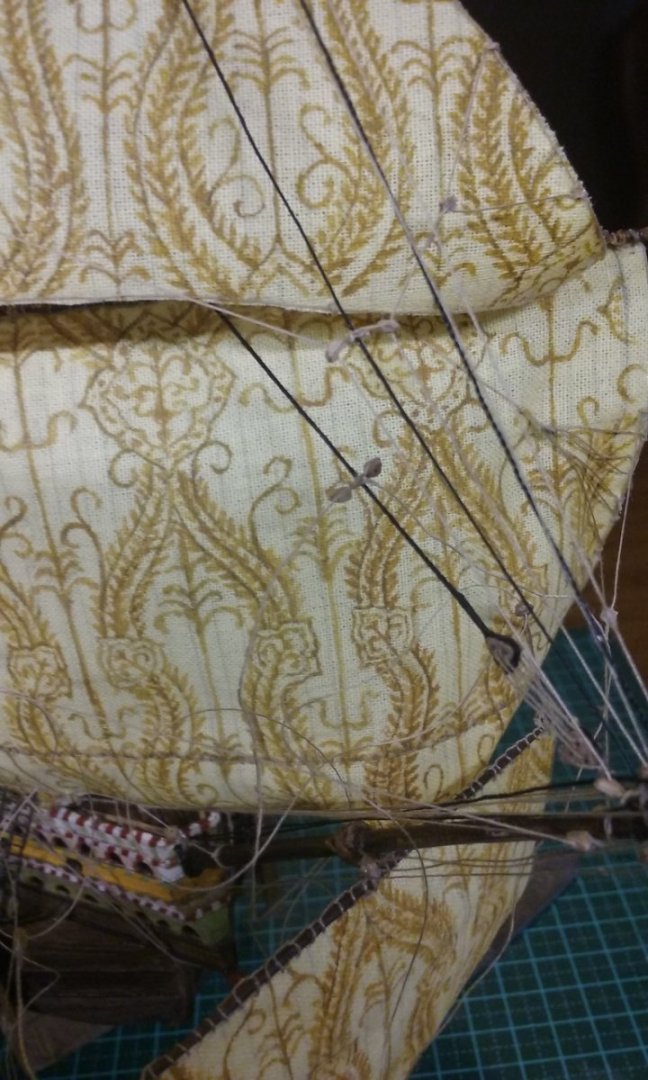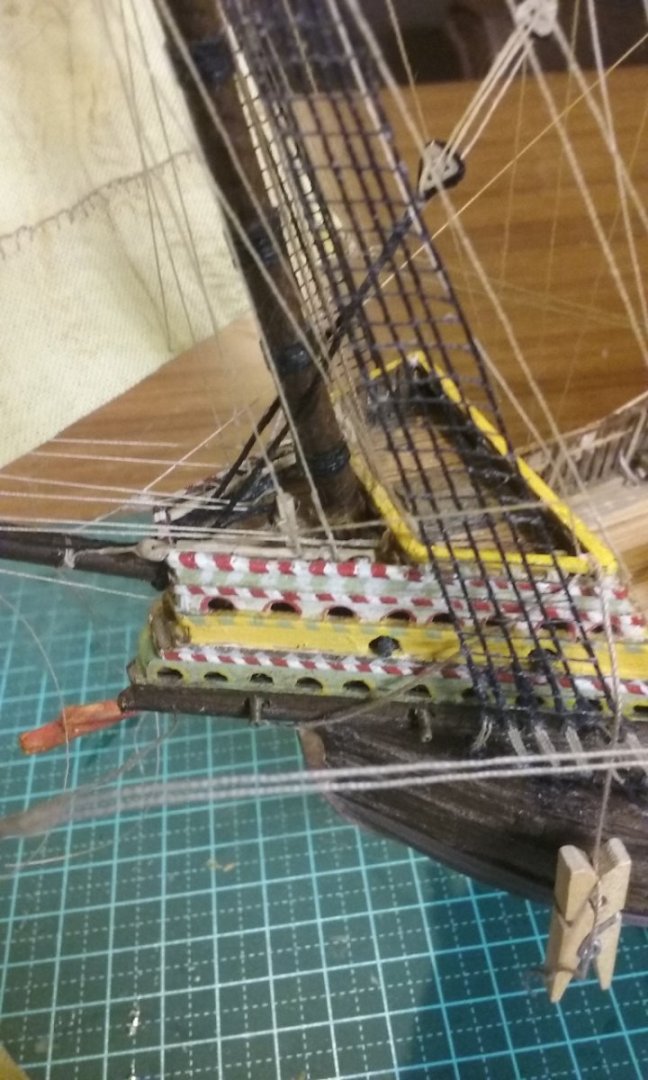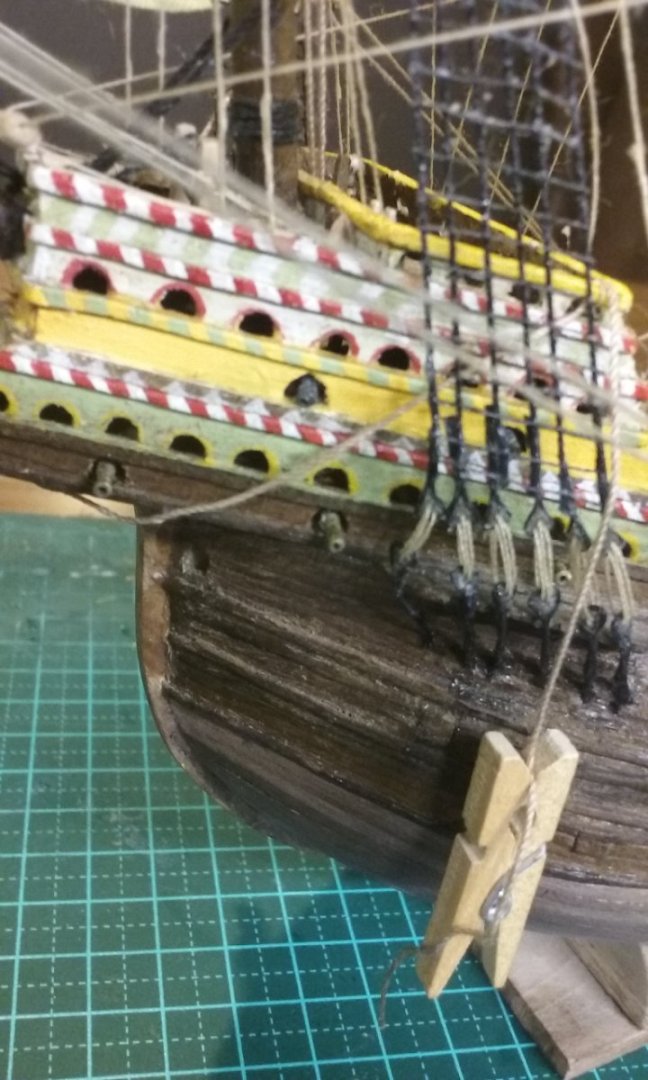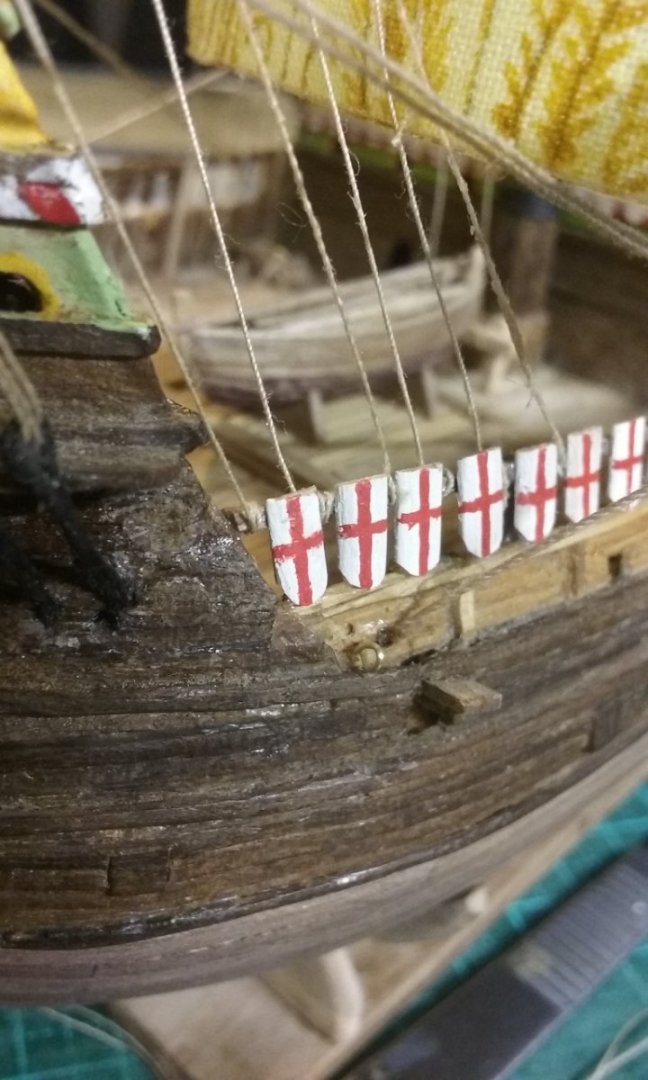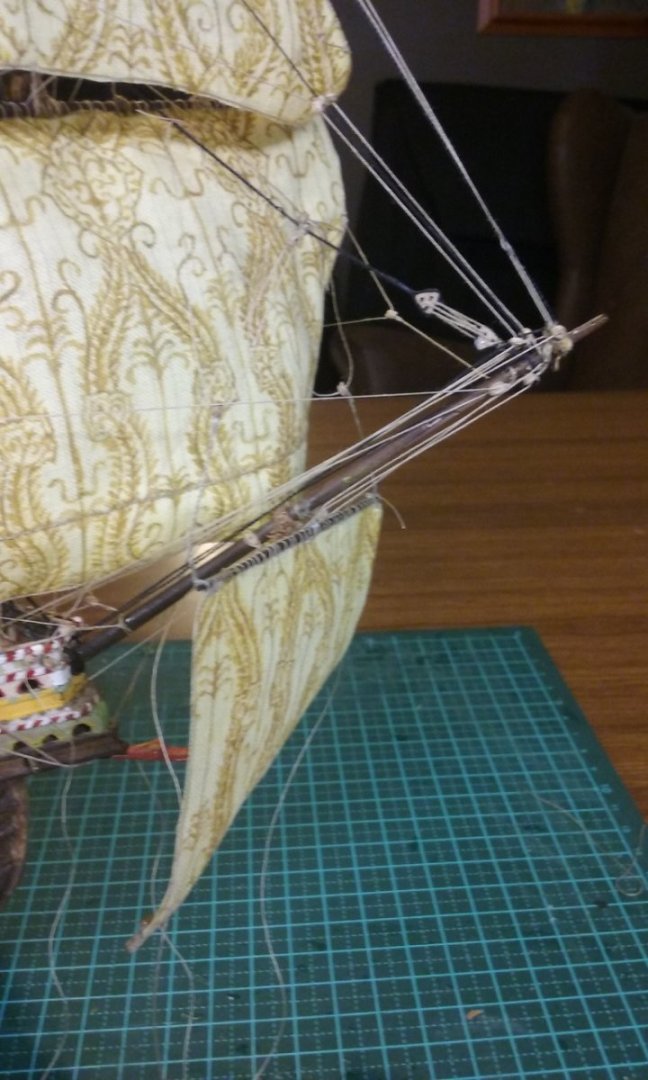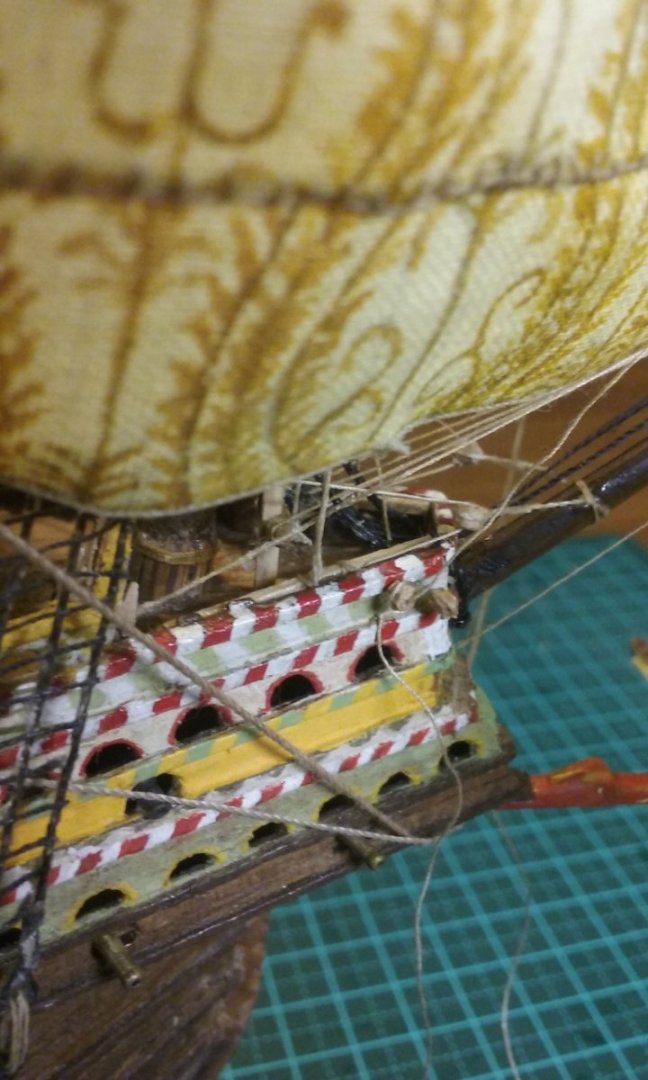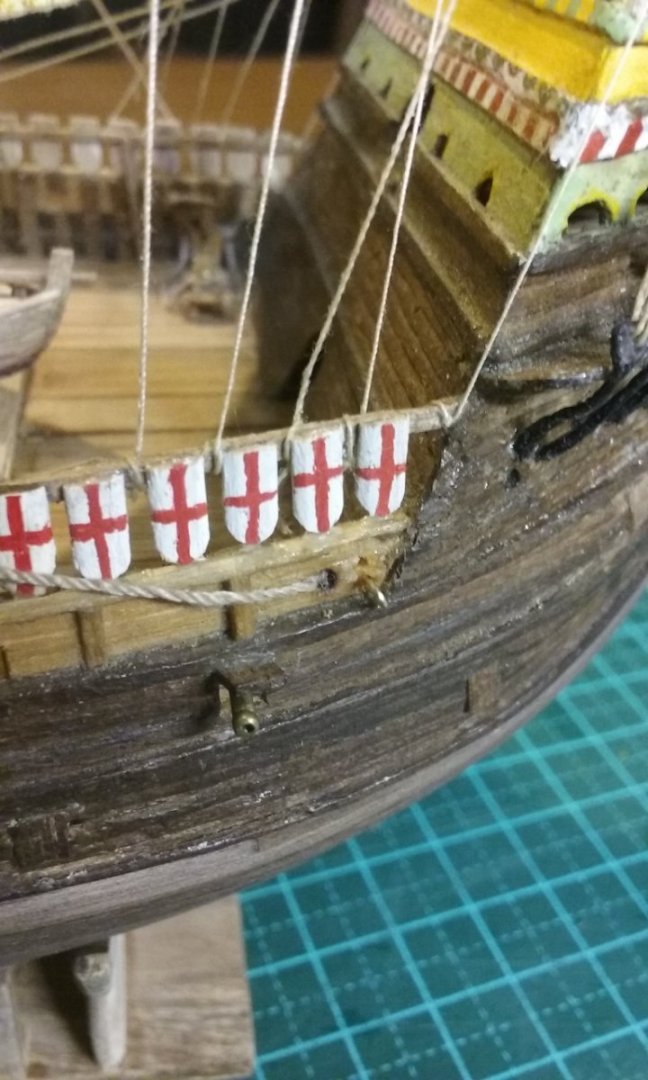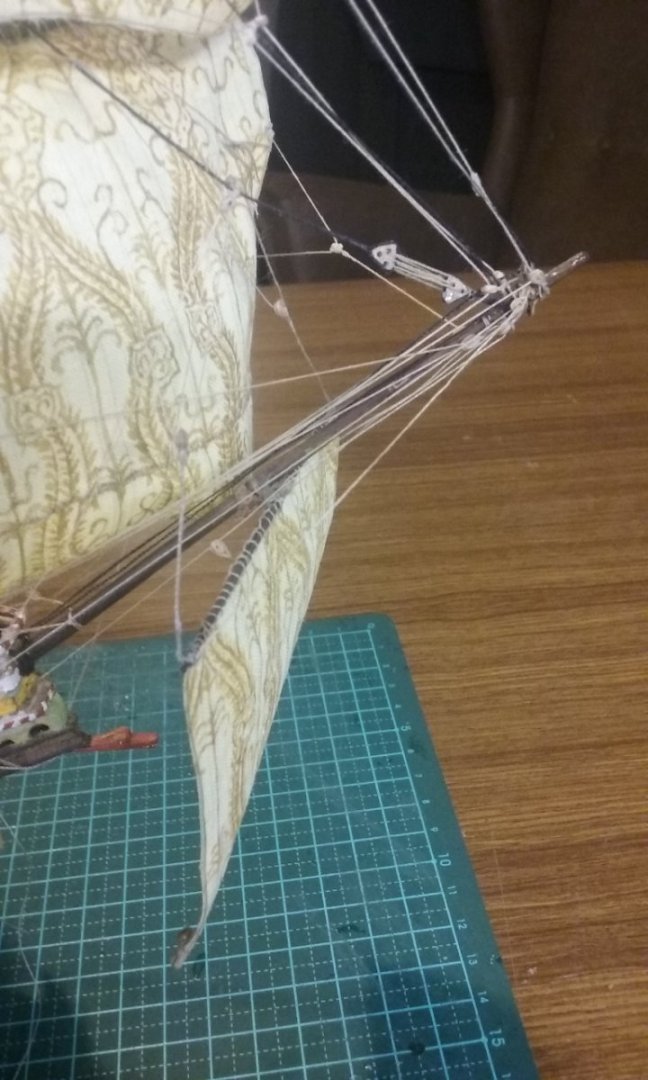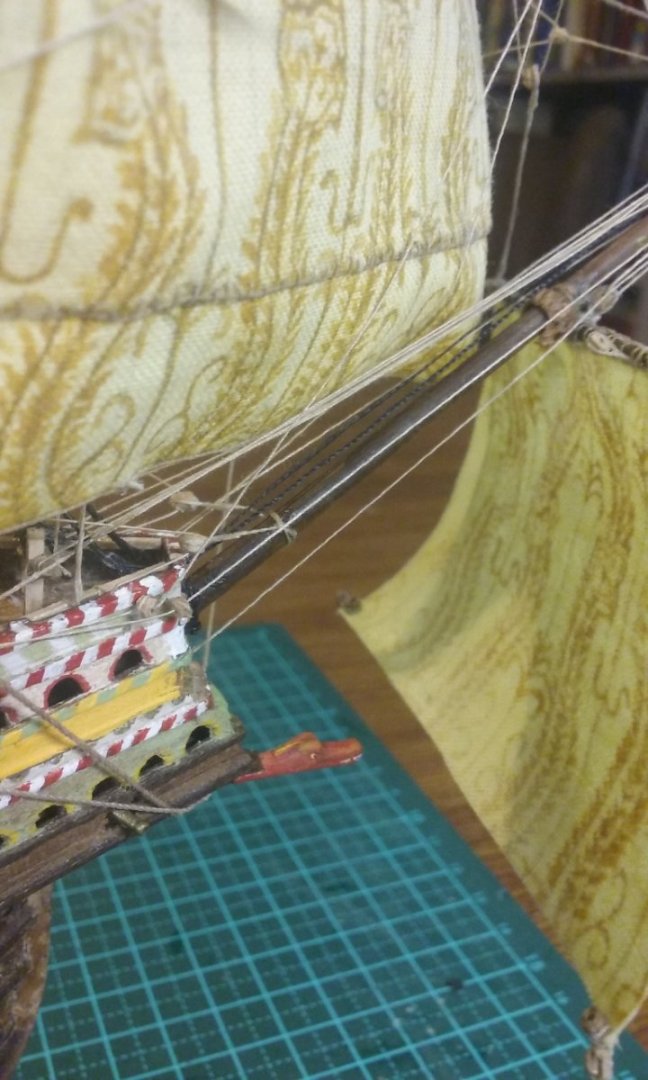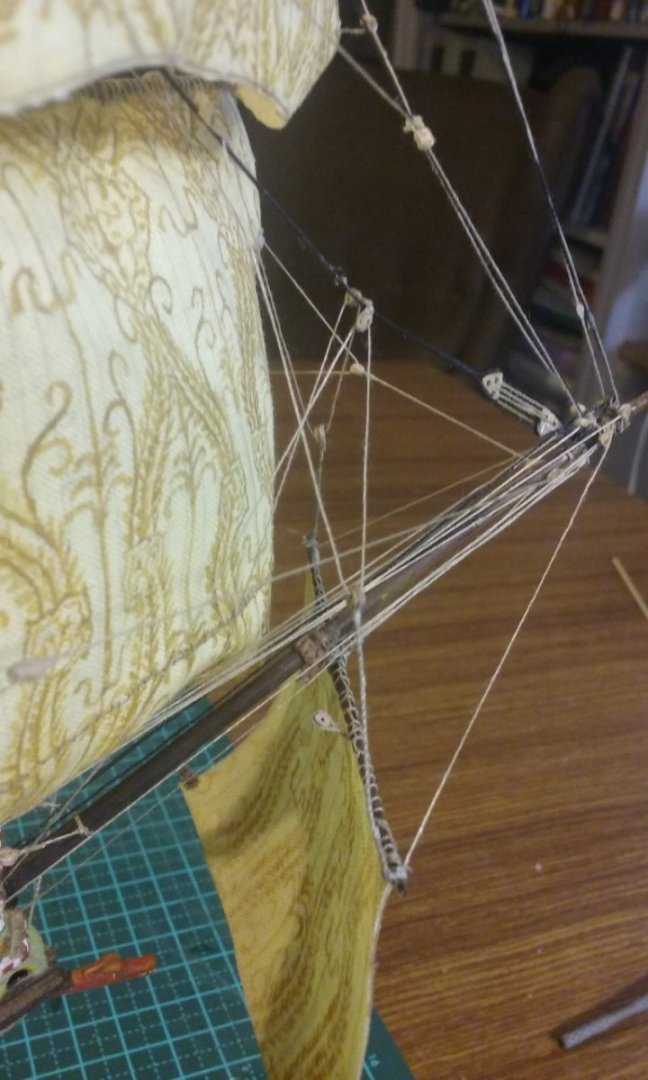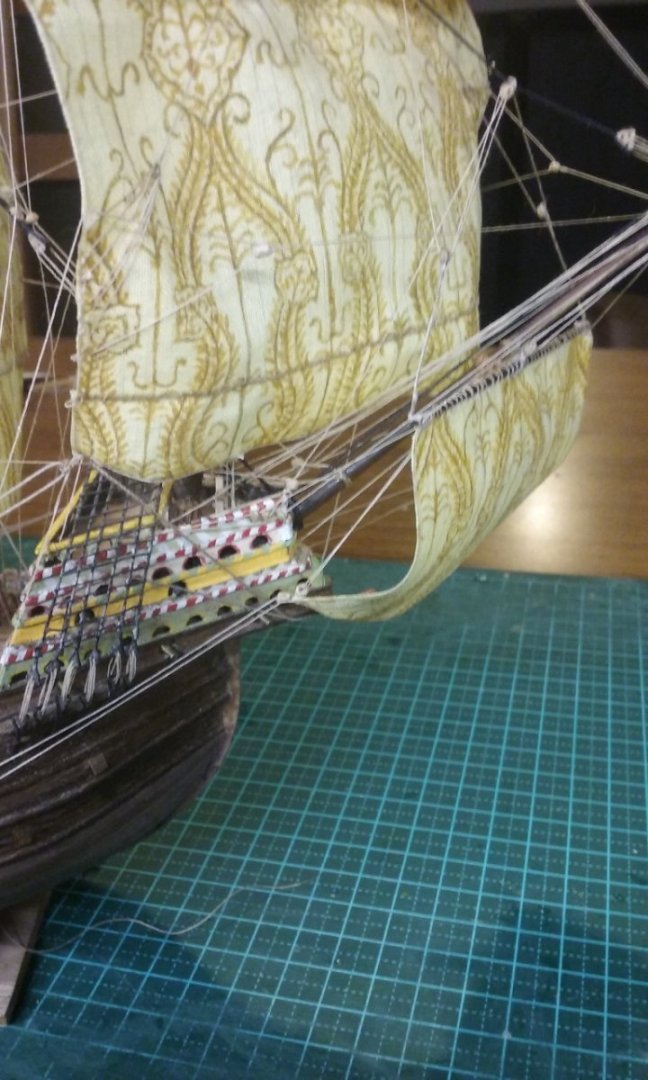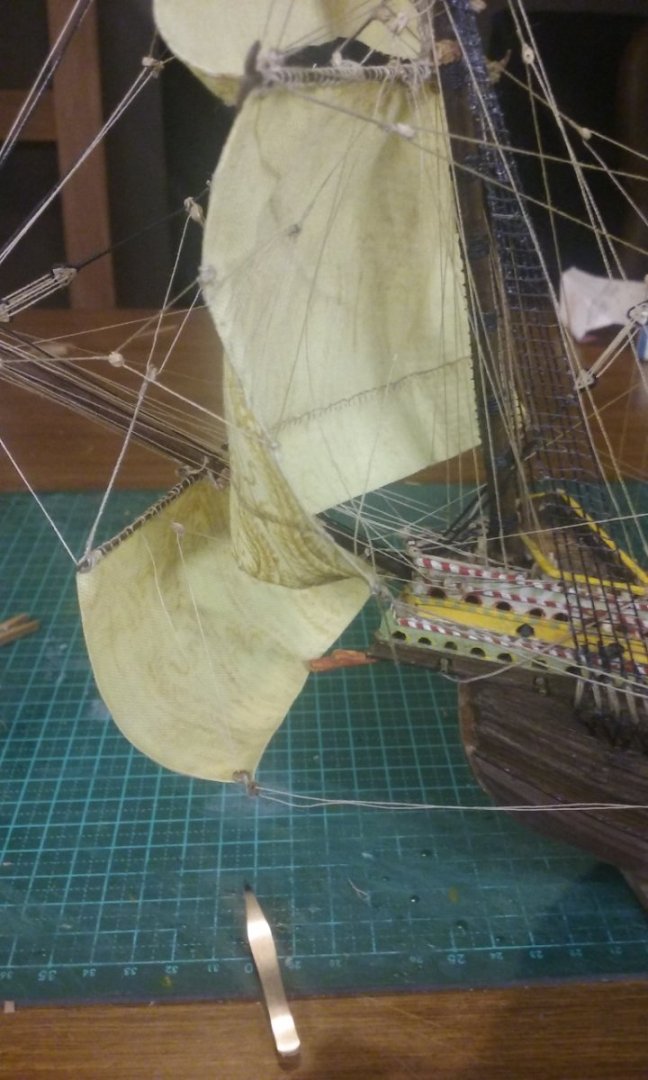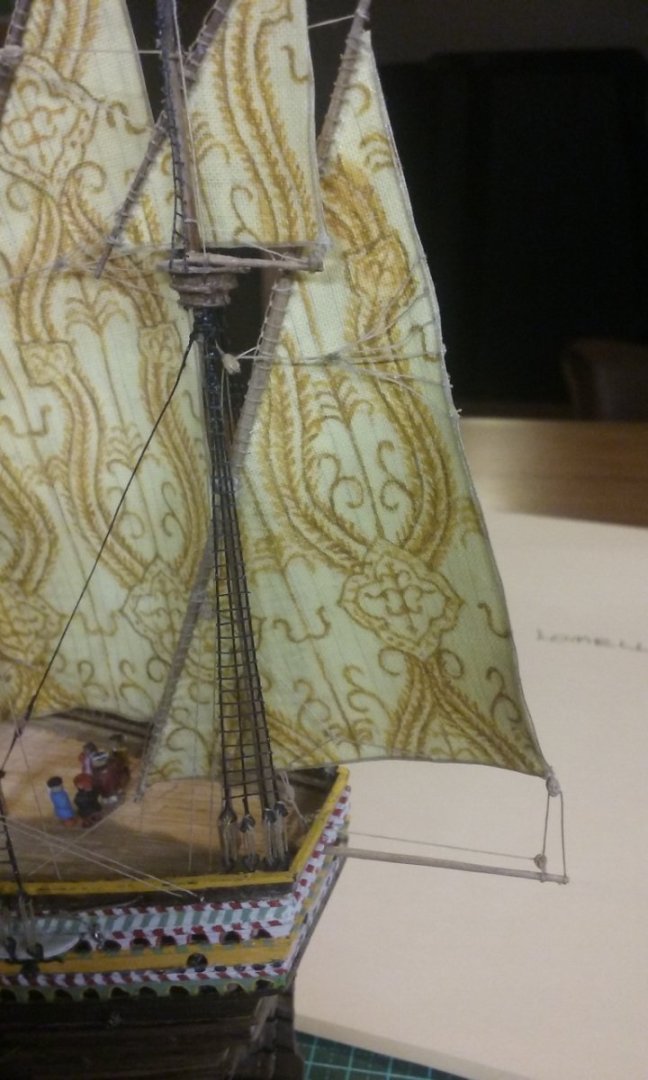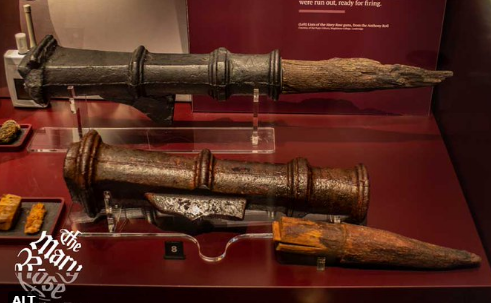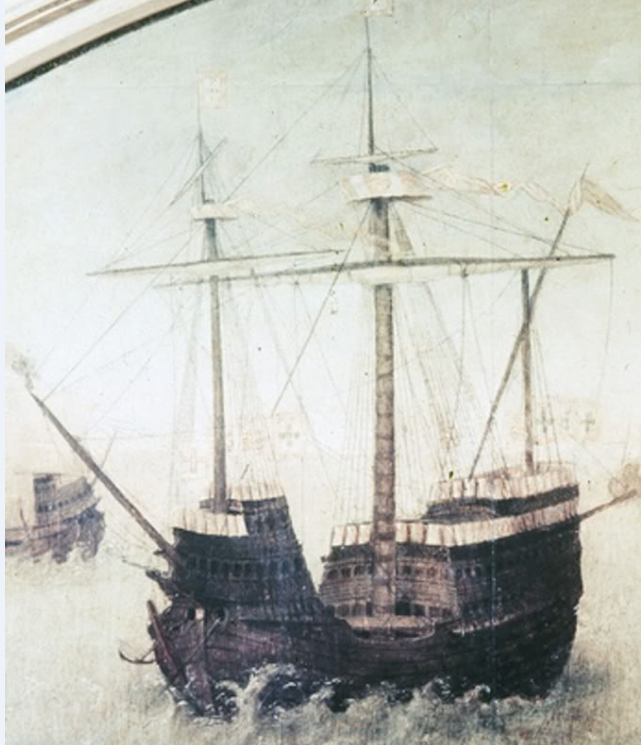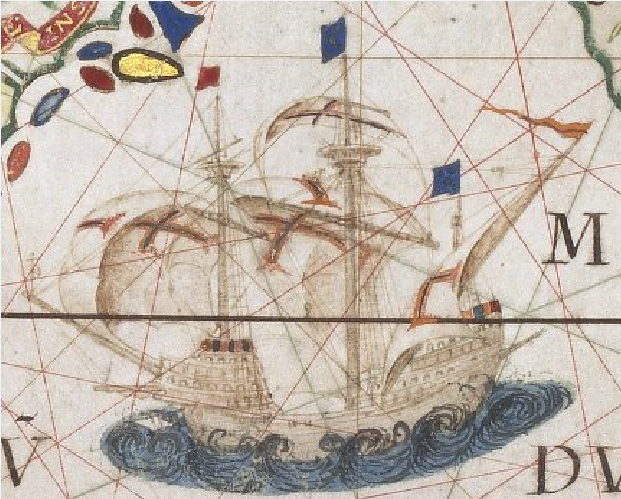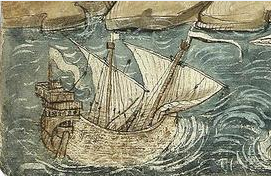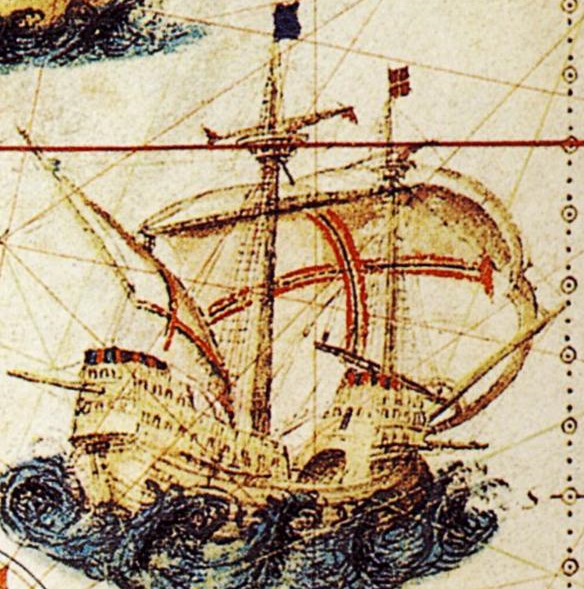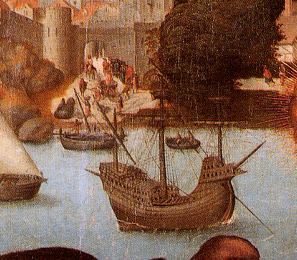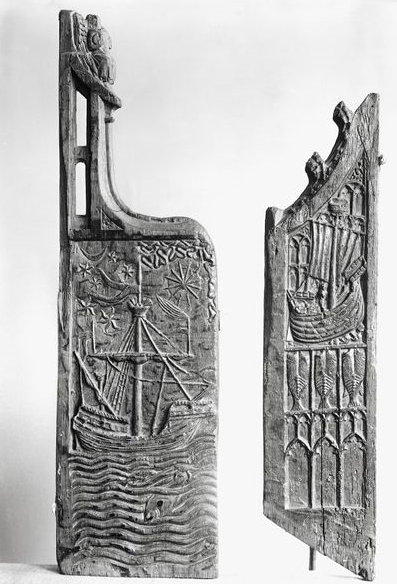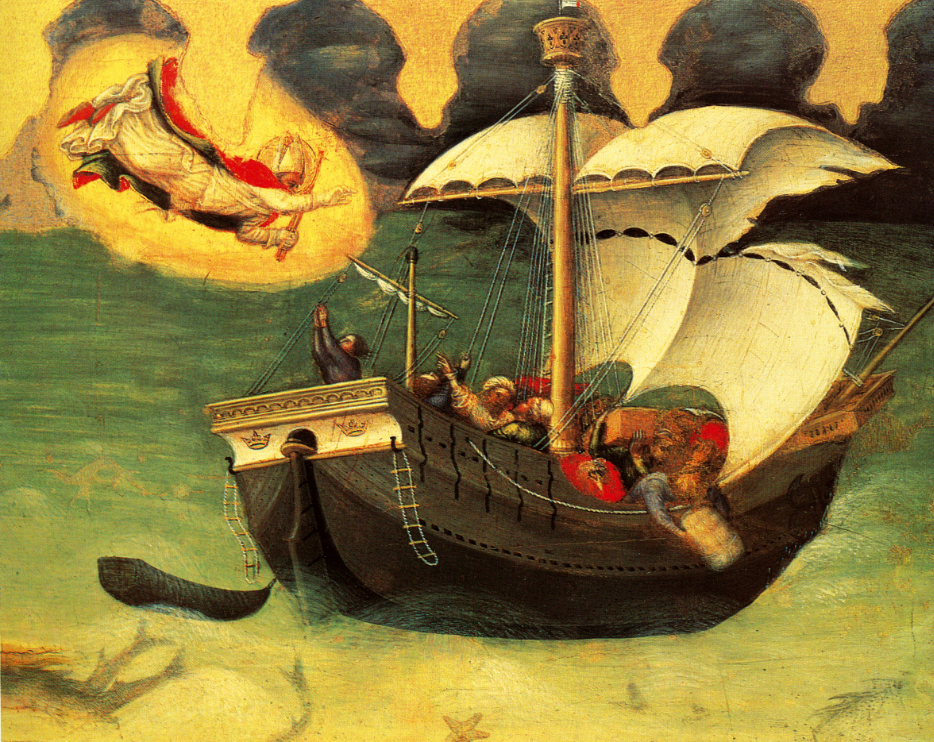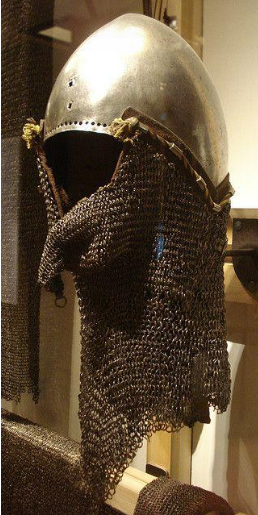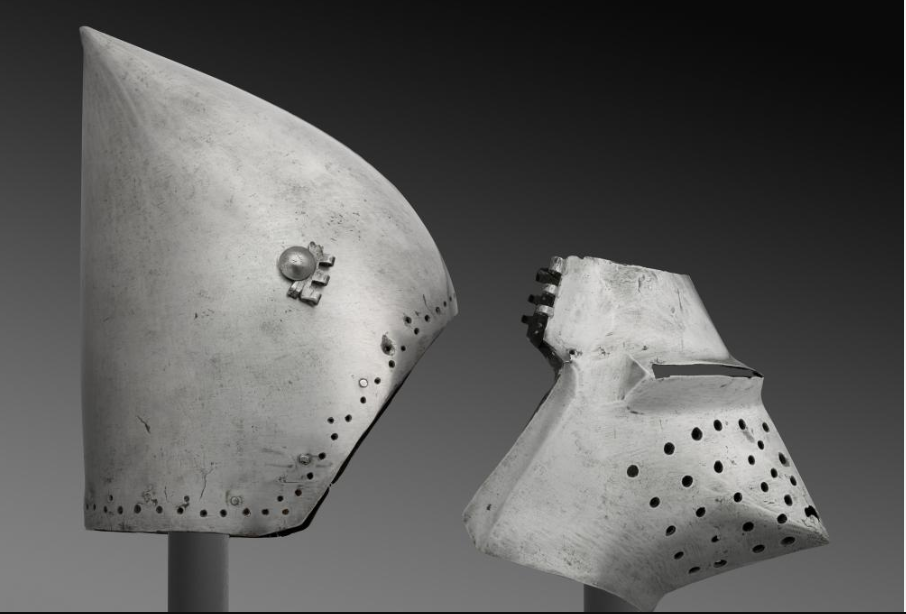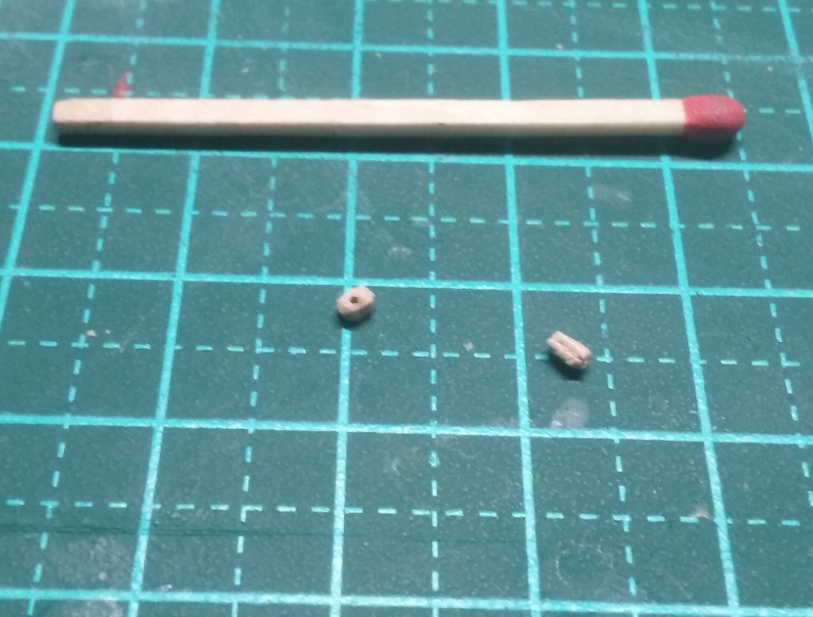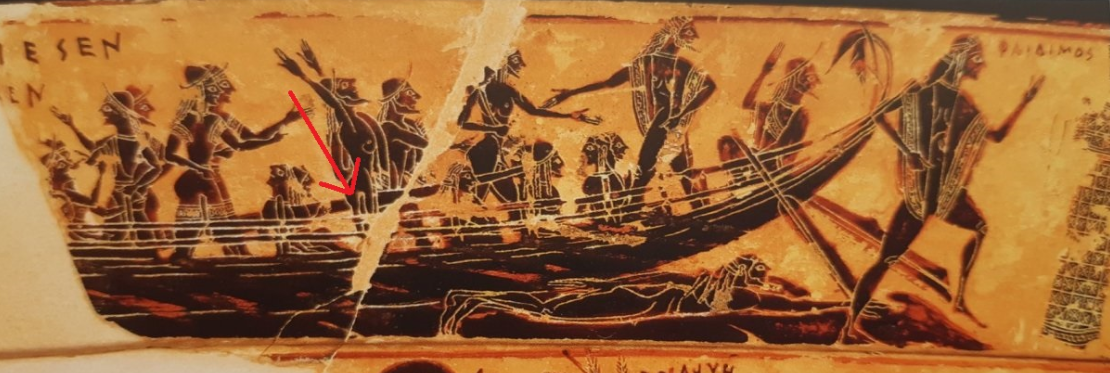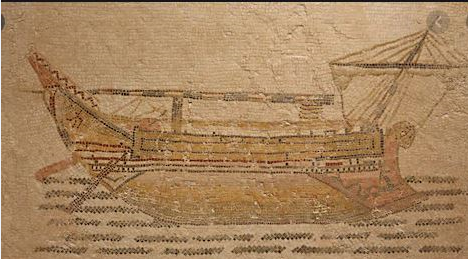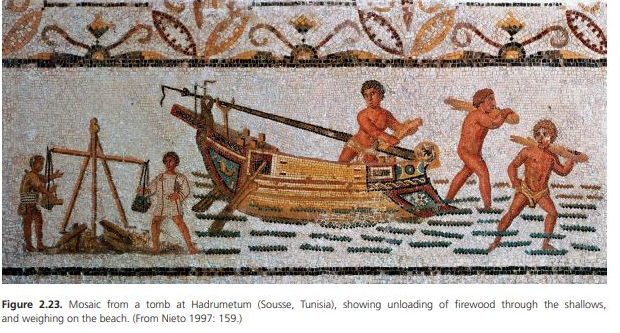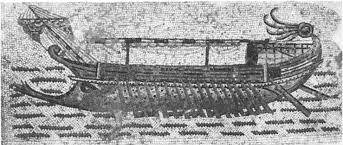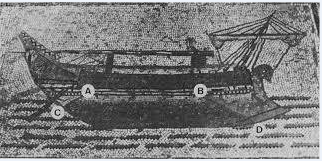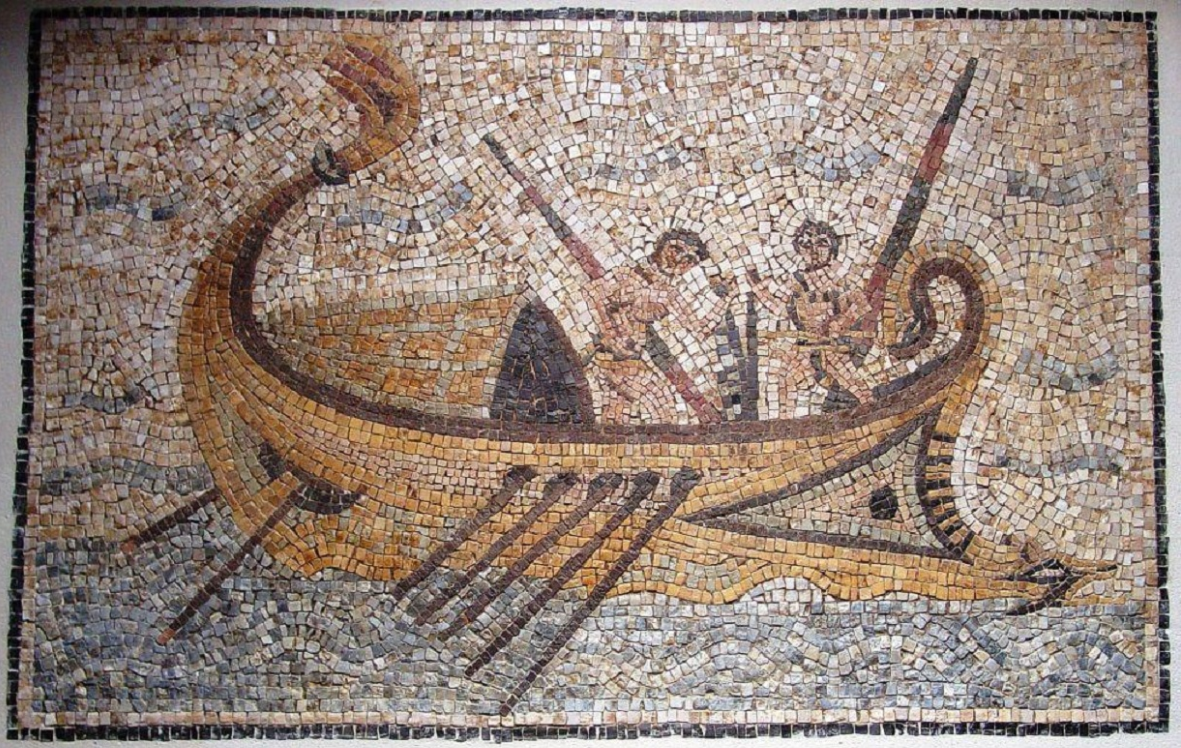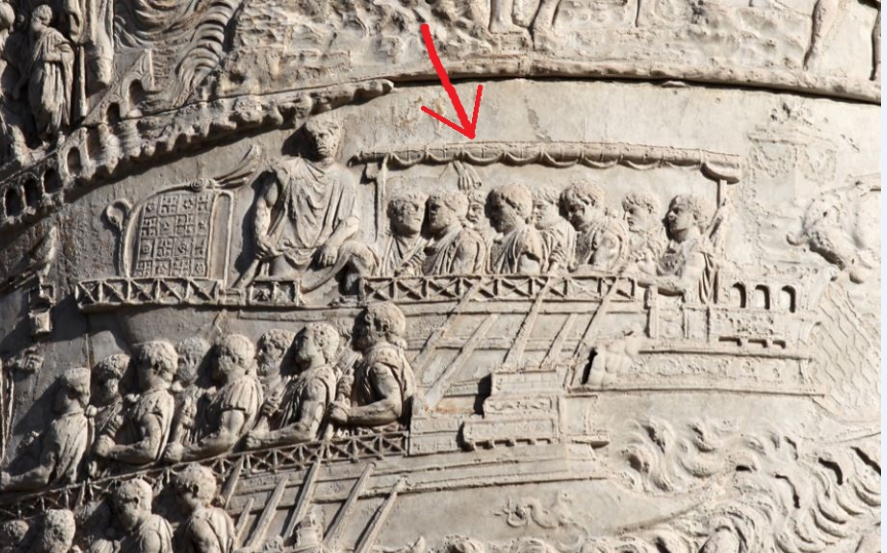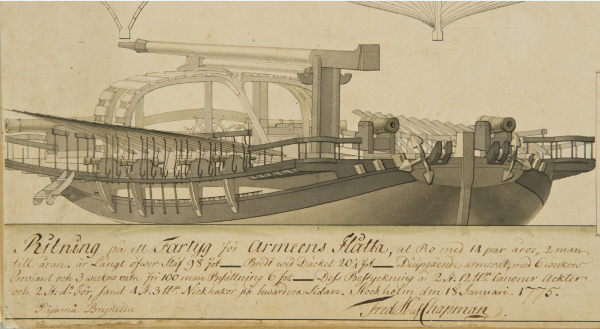-
Posts
7,986 -
Joined
-
Last visited
Content Type
Profiles
Forums
Gallery
Events
Everything posted by Louie da fly
-
I've just added the bowsprit grapnel and its chain. The grapnel is a survival from the original build. It's made of 4 staples (i.e. the things that you staple pages together with) glued together at right angles. The chain I got from some tacky jewellery from a thrift shop ('op shop' in Australian). There are only three ships on the Anthony Roll with grapnel and chain - the Great Harry, the Mary Rose and the Peter Pomegranate (named after the coat of arms of Catherine of Aragon's family, for those who are interested in such things). As far as I know they were the three biggest ships in Henry VIII's navy. Interesting point - Landström shows the chain looping several times - presumably somehow attached to the line that pulls it in and lets it out, running through blocks or something. The original picture shows it running straight up the bowsprit. It raises the question - does the spritsail yard foul the chain, or at least stop it falling down properly as it should, so its full extent is unencumbered? If you look at the Anthony Roll picture, the spritsail is not attached to the bowsprit, but is stored somehow down at the bottom of the forecastle. This ties in with R.C. Anderson's statement "At the beginning of the 17th century the spritsail became for the first time more or less permanently attached to the bowsprit. Before that it had been the custom to take it bodily to the head, yard and all, when the sail was not set." Unlike these vessels, the Great Harry doesn't have a beakhead, and it's an interesting question as to how that spritsail was secured against the forecastle. It's shown the same way in all the big ships in the Anthony Roll. As Landström is showing the ship with all sails set, he's had to show the spritsail in position, and he's had to figure out how to show the configuration of the chain so the yard doesn't get in the way. I don't think it's right, and if, as many believe, the grapnel was for securing an enemy ship to allow boarding, it wouldn't have worked very well. Another interesting point is that in all the other pictures I've seen of vessels (carracks) with a grapnel on the bowsprit, there is no spritsail and the grapnel has an easier fall. The development of the spritsail must have posed a bit of a problem, and perhaps the Great Harry and its sisters were among the last vessels to have a grapnel and chain. All that being said, I've chosen to follow Landström, as I'm already committed. Looking back, I might have chosen a different way of tying up the loops of the chain, but it's as it is, and I'm happy with it. Disregard the background bits and pieces, I was in the middle of doing something else and couldn't be bothered tidying up for the photo. Steven
- 740 replies
-
- Tudor
- restoration
-
(and 4 more)
Tagged with:
-
I'll have to make sure I get down to Williamstown to see her. She's magnificent! Steven
- 88 replies
-
- Australia II
- Finished
-
(and 2 more)
Tagged with:
-
- 142 replies
-
I'd agree about the oculi. It's interesting how small they are on the Maltese luzzu in the photo above. Unless the eye on the duck performs that function. Steven
- 142 replies
-
Patrick, those flags are beautiful. But as I've almost finished the Great Harry's flags I must regretfully decline (I'd hate all my hard work to go to waste). Steven
- 740 replies
-
- Tudor
- restoration
-
(and 4 more)
Tagged with:
-
1. Yes, it's cartoon-like. 2. It might be possible to use shading to make it more naturalistic, as was done in the Middle Ages Funeral effigy of Robert Curthose, Duke of Normandy (died 1134) 3. Given the Mediterranean love of bright plain colours, your version is probably historically correct. Steven
- 142 replies
-
Working on the pennants. A rather fiddly job. Acrylic paint on cotton cloth. A layer of paint needed each side to get the colour to go all the way through. Adding crew members. And restoring pieces I clumsily broke off while working on other things. The little flagstaff with crown on top at the end of the bowsprit: And the "grapnel" at the larboard end of the mainyard. Anchors in place And the first penannt in place; folded to approximate the effect of the wind, and final state. Getting closer to the end. Steven.
- 740 replies
-
- Tudor
- restoration
-
(and 4 more)
Tagged with:
-
Thanks everyone for all the wonderful supportive comments. I have to say I'm not celebrating fully until the whole build is complete. But THEN . . . Steven
- 740 replies
-
- Tudor
- restoration
-
(and 4 more)
Tagged with:
-
I do know what you mean. I've had the same problem. Steven
- 279 replies
-
- Spanish Galleon
- Imai
-
(and 1 more)
Tagged with:
-
I've spoken to Banyan on the phone in between times and he's explained that he uses a dowel to produce the catenary curve in ratlines - the dowel is inserted at right angles between a pair of shrouds and weighs down the ratline between its fixings to the shrouds on either side in a nice smooth curve. Clever idea. Now that the spritsail and its yard are in place, I've been adding the rigging. A pair of blocks fixed to the forestay to take the braces. Belaying the foresail tacks. Ringbolt (eyebolt actually - I can't make a ringbolt at this scale, so I faked it with an eyebolt) to take the spritsail sheet, and a hole drilled in the side of the hull immediately above it, to represent a sheave to take the free end of the sheet through to where it's belayed within the bulwark. The rope right next to these is the maintack. Braces added to the spritsail yardarms. Hanging free at the moment, while the glue dries. Braces going up to the blocks on the forestay. Not very good definition in the first photo, I'm afraid. I needed blocks to take the lines for the spritsail lifts, clewlines and braces back to the forecastle to be belayed. Anderson in The Rigging of Ships in the Days of the Spritsail Topmast puts these on the beakhead. One tiny problem - the Great Harry doesn't have a beakhead. So I had to figure out somewhere I could put the blocks. They should probably have been at the front face of the forecastle but I just didn't have the room to drill holes to take the lines supporting the blocks (strops? I don't quite know what to call them). So I put them along the sides of the forecastle instead, as far forrard as I could. The first photo shows the blocks for the lifts and clewlines. I added the one for the braces later, but the photo isn't all that clear. And everything belayed. I'm not totally happy with the "belly" of the spritsail (nor some of the other sails, for that matter), but I don't think I can do any better under the circumstances, so I'm leaving it as it is. There's an old saying "Better is the enemy of good" and I think it applies in this case. And the outrigger and sheet for the mizzen "course" on the bonaventure mast. You know what this means, don't you? I've FINISHED THE RIGGING! Party time! There's more to do, of course. Adding the little men in the rigging, the anchors and the flags (all the rectangular ones are done and ready to attach, but there's about 7 or 8 pennants that need to be made). And then replacing the two bits I broke off while I was doing the rigging. And then (weather permitting, and if all goes well, and barring accidents and misfortune, and touching wood) the whole build might (possibly - not to put the curse on it) be FINISHED. Steven
- 740 replies
-
- Tudor
- restoration
-
(and 4 more)
Tagged with:
-
Great basket, mate! And in return for my tip on the cling-wrap you gave me one on how to keep the CA cap from sticking to the tube. So Thanks for that. It would never have occurred to me. Steven
- 56 replies
-
- Sea of Galilee Boat
- SE Miller
-
(and 1 more)
Tagged with:
-
Banyan, there seems to be a missing word in your post. "A long . . . what?" (not a criticism - I really want to know). Steven
- 740 replies
-
- Tudor
- restoration
-
(and 4 more)
Tagged with:
-
When I built my dromon on a solid wooden plug, I covered the plug in cling-wrap and it came off with (relatively) little trouble (see If you ever do another strongback model, you might consider covering each bulkhead with cling-wrap as a "resist" rather than tape. I dunno. The techniques are different, and the clingwrap might interfere with planking. But she's looking very good. Did you find she squoze (past tense of squeeze) inwards due to the springiness of the planking when you removed her from the strongback? Or did she retain her shape? Steven
- 56 replies
-
- Sea of Galilee Boat
- SE Miller
-
(and 1 more)
Tagged with:
-
Yes, your diagram makes it clear. Nicely done. Do I agree with the interpretation of the Anthony Roll picture? Not sure. To me it seems the shadow is nil where the forecastle meets the gunwale and gets wider towards the bow, which would be the case if there were no overhang except what is caused by the bow curving away faster than the angle of the (triangular) forecastle. But I'm just throwing that idea out for your consideration, not saying your interpretation is definitely wrong. BTW, are you also thinking of having the forecastle curved in the vertical plane, as shown on the Science Museum model? To me that doesn't seem likely, but I'd like to hear your ideas on it. That all makes a great deal of sense. The reduction in height of the aftercastle, plus the addition of more guns lower down - and probably heavier guns at that, as despite my earlier comment, I do believe there was quite a bit of progress in gunmaking between 1512 and 1536; note the Lomellina, probably built about 1503, just had iron "stave construction" guns with iron strips welded edgewise into a tube and held together by iron rings, while the Mary Rose had those, but also big bronze guns. She certainly sounds BIG. Good luck with that. At least you won't have too many problems with reaching in to make fiddly details. Yes, time-zones can be a bit confusing. But no problem. Keep up the good work. A very interesting discussion. Steven
-
Thanks, Mark. I've tried weak white glue solution - it works to a certain degree, but I don't want to push it too hard in case I mess it up. Wetting the thread seems to help. I'll just keep experimenting. Steven
- 740 replies
-
- Tudor
- restoration
-
(and 4 more)
Tagged with:
-
Hi Johnny, Jeez, you don't give people much time to think over an answer, do you? Let me see, I'll try to reply to both the previous post and this one. First point - I'm not really sure I understand your point about the forecastle having a wider base than the gunwale below. To me it seems that the picture shows the after end of the forecastle is flush with the hull, which then curves away forward to form the bow. But perhaps I'm misunderstanding the point. Do you mean the forecastle is cantilevered out sideways where it meets the hull at the break of the forecastle? And I'm not sure about the curved support you describe - do you mean the gently curving horizontal line that forms lower border of the forecastle? Perhaps that could be interpreted as a curve in the horizontal plane - or is it in the vertical plane (as shown on the "pointed version" Science Museum model - 6th picture in your post #15 above)? Regarding your point (1) in post #15, that's definitely a possibility - I have seen somewhere it proposed that these guns had that function. But depending on their calibre they might still be intended as anti-personnel weapons to defend against enemies who have achieved the weather deck, which would form a "killing field" fired on from both front and back with no means of escape, a common principle in castle architecture of the time. For example, 'hailshot pieces' which fired small iron cubes (a forerunner of canister) could perform that function. As you're surely already aware, I'm in the 'pointy forecastle' school, for two reasons. The first is that almost all representations of carracks and the later ships like the Great Harry (which I choose to call "great carracks") show them with triangular forecastles. Exceptions are the picture of the Battle of Zonchio and some pictures in one of the Cowdray engravings http://www.dominicfontana.co.uk/dominic/maryrose/calaissmall.jpg (which in any case are 19th century copies of a lost original, which allows two opportunities for misinterpretation - once by the original artist, once by the copyist - instead of just one). See the pictures of "great carracks" at https://www.pinterest.com.au/lowe1847/great-carracksnaos/ The second is structural - that amount of weight cantilevered over the bow would force the ship's head down and make her unwieldy to sail, as well as being vulnerable to being shaken apart in heavy seas. I believe this is the reason the triangular forecastle replaced the earlier rectangular one as ships grew bigger. However, I believe they weren't sharp points all the way up - as shown here: Saint Auta altarpiece of 1520 from the Miller Atlas, 1519 It seems to me the forecastle stepped backwards as it went upward, and that would mean the higher 'stepped back' decks would be wider at the forward end, as in the forecastle of my own Great Harry (the 5th picture in your post #15). But even if it came to a sharp point, it seems the bowsprit was often off-centre to miss the foremast, so the problem with it passing through a pointed forecastle might be moot. And another point - galleons, which seem to have come into use about the 1540's, had sharp beakheads, with the forecastle 'proper' further aft - in my view for the same structural reasons as triangular forecastles in carracks. Well, the 'extension of the keel' would be the stempost, but I guess you're talking about the horizontal extension of the stempost, for which I don't have a name either. And interestingly, I hadn't really noticed up to now that Anthony Anthony's Great Harry didn't have a dragon figurehead - I was just assuming it did because Landström's reconstruction picture had one. However, the definition in the images of the Great Harry available on-line is rather vague, to the point that maybe the dragon-head is there after all. Though I agree with your idea of 'seats of ease' toward the front of the forecastle, I think there would still be plenty of room for them in a triangular forecastle. Okay, now onto post #16. I think many contemporary representations of carracks falsely show them as "bulbous" at the bow, and I think this is not so much an accurate representation of reality as a problem with the ability of the artists to show what is, after all, a rather difficult shape. See Woodrat's Venetian Carrack or Cocha - in which he follows the contemporary text-books to determine the shape of the hull, which turns out to be eminently slim and seaworthy after all - a fact supported by the better artists of the time - Carpaccio and Botticelli. I'm not sure the flat stern gave a wider platform for artillery - round carrack sterns should still have been sufficiently wide for artillery where it mattered. Though I agree with your observations about the stern rudder, it had already been in use for quite a while - at least since the late 14th century (though some Mediterranean ships retained it right into the late 15th century). 1487 Mediterranean Merchant ship, Ragusa. von Grunenberg's Beschreibung der Reise von Konstanz nach Jerusalem (Record of the journey from Konstanz to Jerusalem). I agree. OTOH, when Woodrat built his carrack, he was surprised at the amount of space still available in a quite sharply pointed triangular forecastle. The earlier ships with rectangular forecastles (which certainly did exist) were considerably smaller, and I think the problems with structure would have multiplied dramatically as ships got bigger. Finally, as you want to represent the Great Harry as she was when built in 1512-1514, this adds yet another difficulty of interpretation. There are no contemporary pictures of her at that time. The Embarkation at Dover is thought to have been painted around 1545, so is not a reliable record of the ship before her rebuild. I would recommend you look at other pictures of ships of this type from around the time she was built - such as the "marriage" painting (thought to be of the Santa Catarina do Monto Sinai, built 1512), the Saint Auta altarpiece of 1520 (above), the Miller Atlas carracks of 1519 and Lourinha's St John the Evangelist at Patmos of 1510-14 (both below) from the Miller Atlas, 1519 Lourinha's St John the Evangelist at Patmos, 1510-14 I have to say they're not all that different from the Anthony Roll depictions. We know she was up-gunned in the rebuild - according to Wikipedia when launched she had 20 heavy guns - after the rebuild she had 45. Guns from 1512-14 were only little more primitive than in 1536. Quite sophisticated bronze guns were already available by this time, and iron guns when launched weren't all that different from the ones recovered in the 19th century from the 1545 wreck of the Mary Rose. Again according to Wikipedia, when launched she was found to be top-heavy and the height of the hull was reduced in the rebuild. That plus the weight of the additional heavy guns low down would presumably have lowered the centre of gravity and made her more stable. So it seems to me that in 1512-14 she would have had a pretty high forecastle and summer castle, but how high that was is anybody's guess - again, I'd use the pictures I mentioned in the previous couple of paragraphs as a guide, but not rely on them too much. Well, that's about all I can think of. I haven't commented on the purely modelling aspects of your post - I don't think I can usefully add anything to that aspect of things. I hope this is of help - at least it might give you a few things to think about. Best wishes, Steven
-
This is a magnificent model. Something to be proud of. Congratulations on this build, mate! Steven
-
Don't worry about it. Even my own hand-carved blocks are considerably too big for my Great Harry in many places. Who's going to know except you? (and us, of course!) Steven
- 279 replies
-
- Spanish Galleon
- Imai
-
(and 1 more)
Tagged with:
-
Yes, that would make sense. Go for it! Steven
- 536 replies
-
- Quadrireme
- radio
-
(and 1 more)
Tagged with:
-
Hi Marvic, and welcome. My immediate observation is that the guy on the left, though he's in pseudo-classical armour, is wearing a bascinet on his head, which dates to the 14th century. Towards the end of the century the point at the top of the bascinet moved further and further back, so from the bascinet only, I'd guess this is maybe middle-late 14th century or possibly early 15th. Bascinet in the Deutsches Historische Museum Bascinet with visor, dated 1390-1400 in the Philadelphia Berlin, dated to 1360-1370 Museum of Art. This is a fairly extreme example of the "back point" They weren't all so pointy or so far back. However, the fact of having a lateen mizzen suggests a somewhat later date. The earliest pictures I know of that show vessels with a square main and lateen mizzen are early 15th century. This is a pair of pew-ends from the Church of St Nicholas, King's Lynn, UK (now in the Victoria and Albert Museum, London), dating to 1419 Note it has a square mainsail and a lateen mizzen, and also a bowsprit. It also has a rectangular forecastle, something that disappeared in the 15th century to replaced by a triangular forecastle as ships grew larger (as it would make the ship unwieldy in a heavy sea). Unlike the Atlantic, in the Mediterranean there was a tradition of multi-masted ships, but they were all lateen rigged until the advent in the mid-late 14th century of the single-masted square rigged Atlantic cog or kogge, which seems to have been copied in the Mediterranean and give its name to the cocca. The earliest Mediterranean ship I'm aware of with a combination of square mainsail and lateen mizzen is this one of 1425 by Gentile Fabriano of St Nicholas saving a ship from a storm This one has a tiny lateen, a big mainsail and a bowsprit, and the forecastle is polygonal, tapering toward the bow, presumably to overcome the problem I mentioned above. Another point with your painting is that the mainmast is built up from more than one piece of wood, with rings called wooldings around it to keep it together. This is very characteristic of the 15th century. By the way, to my eye the rudder appears central, rather than to one side. It's a bit hard to make out in the painting, but that's how it seems to me. And the rudder has a horizontal tiller which appears to go through an opening in the back of the hull - as in the painting directly above (though nobody seems to be steering!). The stern rudder seems to have come in around the middle of the 14th century and was common among cogs and of course carracks. So, my guess is that the painting is early 15th century. The lack of a main topmast would put it before the end of the 15th century, as they started coming in about 1480 or so, but anyway, the other characteristics make me feel it's in the first few decades. I've made a collection of early 15th century depictions of ships which may also be of assistance - see https://www.pinterest.com.au/lowe1847/early-15th-century-ships/ I hope this helpful to you. Best wishes, Steven Lowe PS: I also have a collection of pictures of carracks arranged in date order. If you'd like them for reference, send me a personal message with your email address and I'll send them to you
-
- 279 replies
-
- Spanish Galleon
- Imai
-
(and 1 more)
Tagged with:
-
Ian, I've posted some information for you on your quadrireme build log. Steven
- 142 replies
-
Ian, replying to your query regarding mast steps on Woodrat's build log so as not to derail his thread. I came across this information when I was researching my dromon. Unfortunately there's almost no information on how dromons' masts were stepped, but for ancient Roman, as far as I know, the mast was "hinged" and when lowered rested on a fork called the istodoke. I have the following pictures: Istodoke from an ancient Greek bowl showing Jason and the Argonauts Istodoke from a 3rd century AD Roman mosaic, Therma, Tunisia, North Africa istodoki from Roman mosaics in Themetra Tunisia Hellenic ship, mosaic (ca 1st century BCE-1st century AD) istodoki on Trajan's column, Rome c. 114 C.E. The same general system was later adopted in the 18th century by the famous ship designer Chapman in Scandinavian gunboats. The "pivot" was called a pulpit, for obvious reasons. I hope that helps. Steven
- 536 replies
-
- Quadrireme
- radio
-
(and 1 more)
Tagged with:
About us
Modelshipworld - Advancing Ship Modeling through Research
SSL Secured
Your security is important for us so this Website is SSL-Secured
NRG Mailing Address
Nautical Research Guild
237 South Lincoln Street
Westmont IL, 60559-1917
Model Ship World ® and the MSW logo are Registered Trademarks, and belong to the Nautical Research Guild (United States Patent and Trademark Office: No. 6,929,264 & No. 6,929,274, registered Dec. 20, 2022)
Helpful Links
About the NRG
If you enjoy building ship models that are historically accurate as well as beautiful, then The Nautical Research Guild (NRG) is just right for you.
The Guild is a non-profit educational organization whose mission is to “Advance Ship Modeling Through Research”. We provide support to our members in their efforts to raise the quality of their model ships.
The Nautical Research Guild has published our world-renowned quarterly magazine, The Nautical Research Journal, since 1955. The pages of the Journal are full of articles by accomplished ship modelers who show you how they create those exquisite details on their models, and by maritime historians who show you the correct details to build. The Journal is available in both print and digital editions. Go to the NRG web site (www.thenrg.org) to download a complimentary digital copy of the Journal. The NRG also publishes plan sets, books and compilations of back issues of the Journal and the former Ships in Scale and Model Ship Builder magazines.



